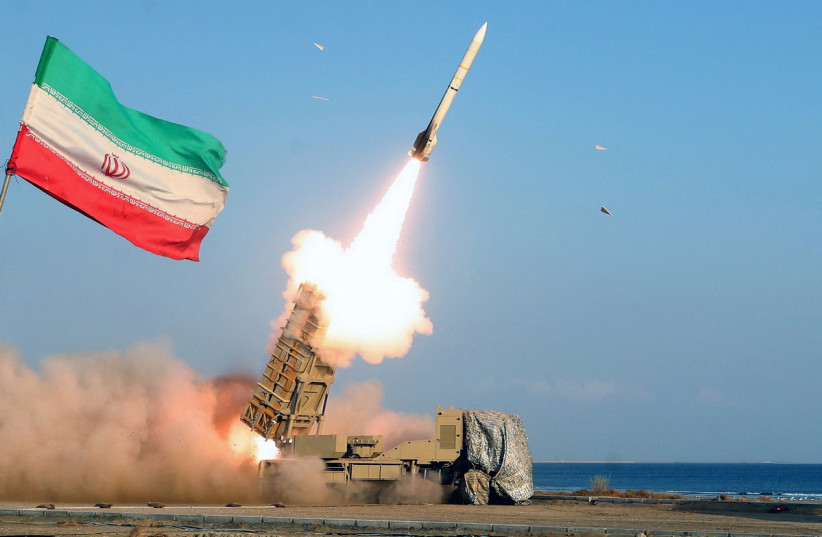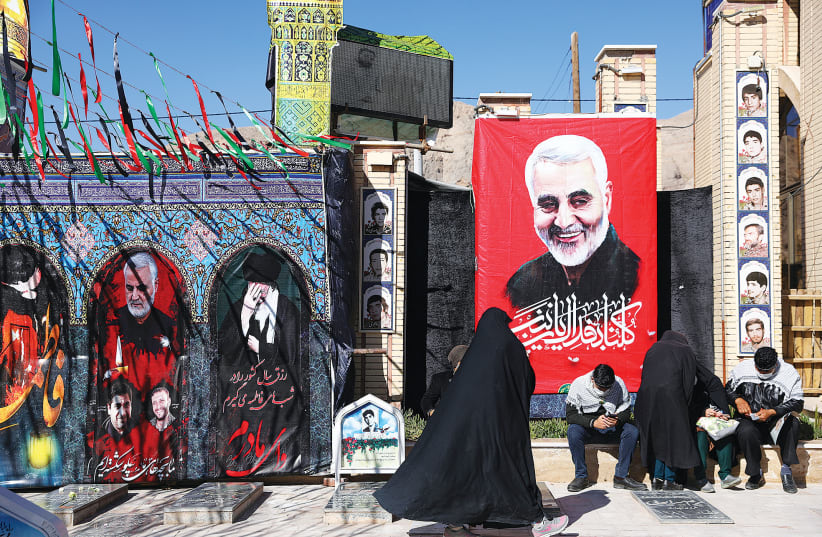Iranian engineer Ali Mahmoudi Mimand, a central figure in Iran’s ballistic missile program, was sitting in his office when a gunman nailed one bullet in his head and disappeared.
No one to this day has taken responsibility for the assassination that happened in the summer of 2001, which may be recalled as a turning point in the protracted, complex, and multi-front war between the Islamic Republic of Iran and the Jewish state.
In their thrilling, revealing, and unsettling new book Target Tehran, veteran Jerusalem Post journalists Ilan Evyatar and Yonah Jeremy Bob visit the events and probe the dilemmas, repercussions, and future of this unusual and fateful war.
Having debriefed scores of key players on both sides of the ocean, including three former Israeli prime ministers and four former heads of the Mossad, the authors shed much-needed light on what has been happening far from the public limelight for nearly a quarter-century, and now – in their view – is but two years away from a potential Armageddon.
The point of no return will be October 2025, when the international limitations imposed on Iran’s production of centrifuges expire, thus opening the way to Tehran’s production of weapons-grade uranium. Even if a new deal does hatch before that, its mechanics will merely delay the point of no return by another five years. But by 2030, a showdown will be inevitable, according to Evyatar and Bob.

An Iran-Israel showdown may be inevitable by 2030
HAVING LASTED as long as it has, the war has been a relay race where batons were passed down to multiple Israeli, American, and Iranian leaders, with the notable exception of Iran’s Supreme Leader Ali Khamenei.
On the Israeli side, the undeclared war appears to have been launched by Ariel Sharon, who shortly after becoming prime minister in 2001 presumably ordered Mimand’s assassination at a time when the Mossad was headed by Efraim Halevy, “whom Sharon considered too cerebral, more of a diplomat than an operations man.”
This attitude changed radically when Halevy was succeeded by the bellicose Meir Dagan, a former IDF general who had fought under Sharon’s command. During Dagan’s eight years at its helm, the Mossad attacked Iran’s nuclear program actively and systematically, continuously diversifying its targets and perfecting its methods, an effort underscored by three known assassinations, all attributed to Israeli agents, although Dagan himself, when asked, said they were “divine intervention”:
Dr. Ardeshir Hosseinpour, an electromagnetics expert who worked on uranium enrichment. In January 2007, he was found dead in his third-floor apartment in Shiraz.
Tehran University physicist Massoud Ali Mohammadi, who died in January 2010 when a motorcycle exploded as he opened his home’s garage when he was “about to leave for the university to give a lecture, as he did every Tuesday at the same time.”
Particle physicist Majid Shahriari, who died later that year when a squad of motorcyclists attached a magnetic bomb to his Peugeot 206 while they were driving through heavy traffic along the Imam Ali Freeway as Shahriari was on his way to work.
Such targeted killings were coupled with equally daring attacks on the nuclear effort’s supply chain and installations, like the one waged in 2021 on a facility some 40 km. west of Tehran by a quadcopter drone that dynamited, and severely damaged, a plant that made parts for centrifuges.
Launched from a location some 15 km. from the plant, the attack was ordered by Naftali Bennett in his second week as prime minister and executed by David Barnea in his third week as head of the Mossad. Israeli leaders and executives come and go, the attack implied, but this meant that all fight the Iranian nuclear effort with equal resolve.
Having begun before the emergence of social networks and the smart phone, the war now sports a separate, and bustling, cybernetic front, involving elaborate offensive and defensive operations on both sides, including one that the authors visited “at a nondescript office in Beersheba.”
Moreover, what began as the war of spooks and geeks, which is the book’s focus, is also raging as a war of terrorism, which Iran feeds through Hamas and Hezbollah, and as a guerrilla war that the Israel Air Force is waging on Iranian outposts and plants mainly in Syria, especially since 2018’s Operation House of Cards.
Such is the diverse, extensive, and protracted war, which raises a question that the book, rightly, answers only implicitly: Who is winning?
PARALLEL TO the war’s clandestine and military fronts sprawls a third arena, diplomacy, in which Israel acts on two levels: the governmental and the public.
On the governmental level, Israel has worked closely with the US and other allies, most notably contributing to the assassination of Revolutionary Guards Commander Qasem Soleimani, as the book scoops.
Less famously, but even more importantly, in 2008 prime minister Ehud Olmert and his defense minister, Ehud Barak, presented to George Bush a plan to attack Iran’s nuclear installations, an idea that Bush vetoed, the authors reveal.
On the public level, the Mossad’s daring theft of Iran’s nuclear archive in 2018 was conceived with the express purpose of swaying world opinion. “We need not only to convince the world that Iran lied about its nuclear weapons program – we need to show the world,” Netanyahu told former Mossad head Yossi Cohen in a conversation recounted in the book.
Dramatic though such tales are, they dwarf in comparison to how the Iranian-Israeli war has impacted the Arab-Israeli conflict.
As the book argues convincingly, and in fact insinuates already in its subtitle, Iran’s regional bullying created the sense of a common threat that produced peace agreements between Israel and two Arab Gulf states, a steadily progressing thaw with Saudi Arabia, and elaborate military cooperation between the three and the Jewish state.
Added up, this is the Khomeini Revolution’s most improbable result, and one of the most spectacular shots in the foot ever fired in the history of strategic aggression.
Just how the direct confrontation between Tehran and Jerusalem unfolds in upcoming years is anyone’s guess, but the Arab-Israeli rapprochement it triggered can already be declared a major victory for the very Zionist project which is the ayatollahs’ obsession, and the target of their bomb.
Target Tehran: How Israel Is Using Sabotage, Cyberwarfare, Assassination – and Secret Diplomacy – to Stop a Nuclear Iran and Create a New Middle EastBy Yonah Jeremy Bob and Ilan EvyatarSimon and Schuster, 2023368 pages, $28.99
www.MiddleIsrael.net
The writer, a Hartman Institute fellow, is the author of the bestselling Mitzad Ha’ivelet Ha’yehudi (The Jewish March of Folly, Yediot Sefarim, 2019), a revisionist history of the Jewish people’s political leadership.
